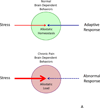Transforming pain medicine: adapting to science and society
- PMID: 23468059
- PMCID: PMC3681852
- DOI: 10.1002/j.1532-2149.2013.00297.x
Transforming pain medicine: adapting to science and society
Abstract
The field of chronic pain medicine is currently facing enormous challenges. The incidence of chronic pain is increasing worldwide, particularly in the developed world. As a result, chronic pain is imposing a growing burden on Western societies in terms of cost of medical care and lost productivity. This burden is exacerbated by the fact that despite research efforts and a huge expenditure on treatment for chronic pain, clinicians have no highly effective treatments or definitive diagnostic measures for patients. The lack of an objective measure for pain impedes basic research into the biological and psychological mechanisms of chronic pain and clinical research into treatment efficacy. The development of objective measurements of pain and ability to predict treatment responses in the individual patient is critical to improving pain management. Finally, pain medicine must embrace the development of a new evidence-based therapeutic model that recognizes the highly individual nature of responsiveness to pain treatments, integrates bio-psycho-behavioural approaches, and requires proof of clinical effectiveness for the various treatments we offer our patients. In the long-term these approaches will contribute to providing better diagnoses and more effective treatments to lessen the current challenges in pain medicine.
© 2013 European Federation of International Association for the Study of Pain Chapters.
Figures






Similar articles
-
The future of Cochrane Neonatal.Early Hum Dev. 2020 Nov;150:105191. doi: 10.1016/j.earlhumdev.2020.105191. Epub 2020 Sep 12. Early Hum Dev. 2020. PMID: 33036834
-
Comparative Efficacy and Mechanisms of a Single-Session Pain Psychology Class in Chronic Low Back Pain: Study Protocol for a Randomized Controlled Trial.Trials. 2018 Mar 6;19(1):165. doi: 10.1186/s13063-018-2537-3. Trials. 2018. PMID: 29510735 Free PMC article.
-
Efficacy and mechanisms of a single-session behavioral medicine class among patients with chronic pain taking prescription opioids: study protocol for a randomized controlled trial.Trials. 2020 Jun 12;21(1):521. doi: 10.1186/s13063-020-04415-x. Trials. 2020. PMID: 32532346 Free PMC article.
-
A holistic approach to chronic pain management that involves all stakeholders: change is needed.Curr Med Res Opin. 2015;31(9):1743-54. doi: 10.1185/03007995.2015.1072088. Epub 2015 Aug 20. Curr Med Res Opin. 2015. PMID: 26172982 Review.
-
Psychological approaches to chronic pain management: evidence and challenges.Br J Anaesth. 2013 Jul;111(1):59-63. doi: 10.1093/bja/aet207. Br J Anaesth. 2013. PMID: 23794646 Review.
Cited by
-
Vulvodynia: a consideration of clinical and methodological research challenges and recommended solutions.J Pain Res. 2017 Oct 9;10:2425-2436. doi: 10.2147/JPR.S126259. eCollection 2017. J Pain Res. 2017. PMID: 29070953 Free PMC article. Review.
-
Region-Resolved Quantitative Proteome Profiling Reveals Molecular Dynamics Associated With Chronic Pain in the PNS and Spinal Cord.Front Mol Neurosci. 2018 Aug 14;11:259. doi: 10.3389/fnmol.2018.00259. eCollection 2018. Front Mol Neurosci. 2018. PMID: 30154697 Free PMC article.
-
Ten simple rules for predictive modeling of individual differences in neuroimaging.Neuroimage. 2019 Jun;193:35-45. doi: 10.1016/j.neuroimage.2019.02.057. Epub 2019 Mar 1. Neuroimage. 2019. PMID: 30831310 Free PMC article. Review.
-
Signature for Pain Recovery IN Teens (SPRINT): protocol for a multisite prospective signature study in chronic musculoskeletal pain.BMJ Open. 2022 Jun 8;12(6):e061548. doi: 10.1136/bmjopen-2022-061548. BMJ Open. 2022. PMID: 35676017 Free PMC article.
-
Psychological processing in chronic pain: a neural systems approach.Neurosci Biobehav Rev. 2014 Feb;39:61-78. doi: 10.1016/j.neubiorev.2013.12.006. Epub 2013 Dec 27. Neurosci Biobehav Rev. 2014. PMID: 24374383 Free PMC article. Review.
References
-
- Ablin JN, Buskila D, Clauw DJ. Biomarkers in fibromyalgia. Curr Pain Headache Rep. 2009;13:343–349. - PubMed
-
- Antal A, Paulus W. Transcranial magnetic and direct current stimulation in the therapy of pain. Schmerz. 2010;24:161–166. - PubMed
-
- Astin JA. Why patients use alternative medicine: results of a national study. JAMA : the journal of the American Medical Association. 1998;279:1548–1553. - PubMed
-
- Badia X, Magaz S, Gutierrez L, Galvan J. The burden of migraine in Spain: beyond direct costs. Pharmacoeconomics. 2004;22:591–603. - PubMed
Publication types
MeSH terms
Grants and funding
LinkOut - more resources
Full Text Sources
Other Literature Sources
Medical
Research Materials

